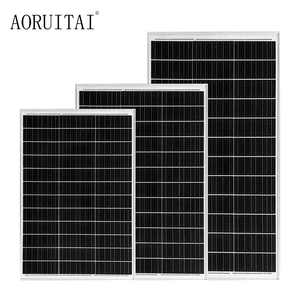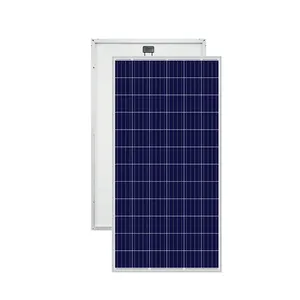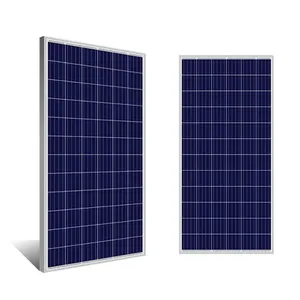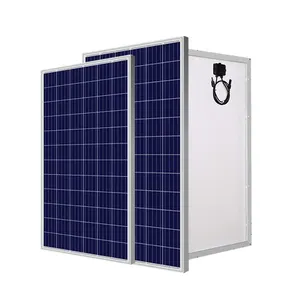
All categories
Featured selections
Trade Assurance
Buyer Central
Help Center
Get the app
Become a supplier

(2911 products available)




















































Following are the types of the offered 18V 60W monocrystalline solar panels:
Fixed solar panels
These fixed solar panels have a certain angle on the mount, roof, or another surface, and the angle cannot be changed. The positioning is fixed, which means that a system does not move with the sun as it changes position throughout the day, and it will always get the same amount of sunlight as its fixed position. Because of its fixed positioning, it is fine for use on the roof of a building, and it is easy to install. It is also relatively inexpensive compared to other types of solar panels that track the sun and are more complicated in construction and installation.
Tracking solar panels
These solar panels have special mechanisms that allow the solar panel to move and follow the path of the sun as it moves across the sky. There are two main types of tracking solar panels: single-axis trackers and double-axis trackers. A single-axis tracker moves on only one axis to follow the sun once a day, moving from east to west, and it is fixed on one side of the horizontal or tilted tracker. It is simple compared to the double-axis tracker, which rotates on two axes, allowing it to follow the sun throughout every hour to maximize coverage. These types of tracking systems can improve the output by increasing the amount of energy production by almost 20-50% compared to fixed solar panel systems.
Building-integrated photovoltaic (BIPV) solar panels
These solar panels are designed to serve a dual purpose, as they both provide electricity and serve as part of the building's façade or roof. These panels are the same as conventional building materials. BIPV solar panels can replace regular roof shingles or exterior wall materials while capturing solar energy. They come in various styles and colors. BIPV systems are commonly installed in new construction or major renovation projects where design with aesthetics are prioritized along with energy efficiency.
Agriculture
Agricultural practices have been using solar energy to power irrigation systems, water pumps, and greenhouse heating to reduce dependency on non-renewable and cheaper energy sources. The solar energy stored in the 18V 60W monocrystalline solar panels is then used to run electrical equipment like fans, lights, and heating systems, and this especially happens in off-grid greenhouses or farms.
Military and defense
The military and defense sector is one of the industries that serve as a testbed for solar technologies because of its unique operational needs. It helps the military and defense sectors reduce the use of diesel fuel for remote operations. Solar panels are integrated into tents, portable power packs, and vehicles to provide power for communications, surveillance equipment, and other important mission-critical systems. Solar energy was used to reduce the logistical burden of transporting fuel, and now it increases the sustainability of its operations.
Transportation
Transportation systems have been incorporating solar panels to power the system's elements or to help in reducing the consumption of conventional fossil fuels. For example, solar panels have been used to power electronic systems like lights, signs, and signals within the trains and buses, including the monocrystalline solar panels. In an attempt to produce more environmental-friendly vehicles, solar technologies are being explored to integrate them into the design of electric vehicles (EVs), where the panels would provide an auxiliary charging system for the batteries.
Telecommunications
Telecommunications are another type of industry that commonly uses solar power, especially for remote sites. Cellular towers, satellite communications, and other telecom equipment have been powered using solar energy, eliminating the need for costly and complicated grid power. It is further used to power equipment in rural regions without electricity or where it is impractical to connect to the electrical grid.
Oil and gas industry
In the oil and gas extraction industry, solar panels can be used to power remote drilling rigs, extraction equipment, and to supply electricity for operations that are not in proximity to electrical power lines. Solar energy helps to reduce the dependency on diesel generators, which are often used to provide needed electricity. It contributes to the reduction of greenhouse gases and the overall environmental impact of energy extraction.
The specifications and features of the 18V 60W monocrystalline solar panels are discussed below:
Key features
Here are the features of the 18V 60W monocrystalline solar panels:
How to install
The installation process of the 18v 60w monocrystalline solar panel is given below:
Maintenance and repair
The maintenance and repair of the 18V 60W monocrystalline solar panels are:
Following are the benefits of the 18V 60W monocrystalline solar panels:
High efficiency
Among the available types of solar panels, monocrystalline solar panels are considered to be the most efficient. They can convert more sunlight into electricity due to the cells made from a single crystal structure. With this efficiency, they are able to generate more power, even in limited spaces, where sunlight can be directly accessed.
Space-saving design
The compact design allows these solar panels to be used in applications that require their users to have limited spaces, such as urban rooftops and portable solar power systems.
Durability
These solar panels are built to last long and withstand harsh weather conditions, such as hail, wind, and extreme temperatures. In addition, they come with warranties covering their performance for 25 years or more.
Easy installation
The solar panels contain lightweight and pre-drilled designs that make installation quick and easy, whether the process is for roof-mounted or ground-mounted systems.
Versatile applications
These solar panels suit various applications: residential, commercial, and off-grid settings, including RVs and boats for portable solar power. It makes it possible to provide flexible solar solutions for more energy needs.
The buyer's guide for choosing the 18V 60W monocrystalline solar panels is given below:
Efficiency
Panel efficiency means how well a solar panel converts sunlight into electricity, and it is an important factor to consider for solar panel buyers. Buying highly efficient panels like monocrystalline solar panels means they will generate more electricity even in limited sunlight conditions. This is especially useful when space is limited, such as on rooftops because more power output is packed in a single watt.
Durability
Since solar panels are exposed to harsh weather conditions for years, it is important to buy durable and durable panels. It includes materials that ensure they are built to withstand hail, strong winds, and extreme heat, including waterproof backing. This prolongs the life of the system and ensures reliable performance.
Installation requirements
Buyers need to consider how the solar panels will be installed on their roofs or properties and the mounting options available, whether fixed or tracking. They also know if the installation is easy or complicated and what additional requirements or equipment are needed for integration with inverters. Choosing compatible panels and systems that make the installation process fast and hassle-free is better.
Maintenance
Maintenance is something to consider since solar panels do not require much work to be famous. Most modern solar panels, including 18V 60W monocrystalline solar panels, are designed with self-cleaning properties and minimal maintenance demands to be easy and convenient.
Cost
Although the initial cost is an important factor to consider when deciding to buy solar panels, long-term savings, including reduced electric bills, are offset by the initial installation costs. Buyers should compare the costs of different solar panel types, warranty lengths, and efficiency levels to determine which option provides the best value for money in the long run.
Here are some common causes of the malfunction of the 18V 60W polycrystalline solar power panels:
Shading
Shading, whether partial or total, from trees, buildings, or even dirt accumulation, can significantly reduce the solar panel power output or even cause a panel to stop working completely.
Hotspotting
Hotspotting refers to the situation where one or some cells in a solar panel are overly heated due to factors like dirt, damage, or shading. This can lead to panel damage, reduced power output, and even complete panel failure.
Electrical issues
Wiring issues like loose connections, broken wires, and faulty diodes create electrical problems that cause solar panels to underperform or stop working entirely. These issues are commonly tied to improper installation or aging panels.
Weather-related damage
Extreme weather like hail, wind, or snow can damage solar panels. These conditions may cause physical damage to the panel itself or impact the frame and glass over time.
Component failure
Solar inverters, mounting systems, and other components related to the solar energy system eventually fail over time due to wear and tear. This causes the entire system to malfunction. Other parts may also fail due to low-quality component use.
Poor maintenance
Lack of maintenance and cleaning allow dirt, debris, and other conditions to accumulate on the solar panel, reducing its efficiency and causing potential damage. It includes not checking for damage and not replacing faulty parts.
The things to do to prolong the life of solar panels include maintaining a proper system, monitoring and optimizing system performance, and applying protective measures to prevent environmental damage. People can extend the life of their solar panels by carrying out these daily, routine, preventive, and corrective maintenance activities. It replaces and fixes faulty parts, cleans and checks the system, and protects the panels from damage.
Solar panels do not waste electrical energy since they are designed to convert sunlight that hits them into usable electricity. They capture the sun rays and generate direct current (DC) power through the photovoltaic effect, which is then converted into alternating current power by the inverter for home use. There are no electrical energy losses in this process, despite some inherent inefficiencies such as shading, dirt, panel temperature, and others.
The inverter role is to convert direct current (DC) power that the solar panels generate into alternating current (AC) power used by most household appliances. The inverter also has the role of maximizing power output, monitoring system performance, and providing safety features like circuit breakage and ground fault detection. It cannot let the current flow back to the panels during the night when there is no sunlight, which causes potential safety issues.